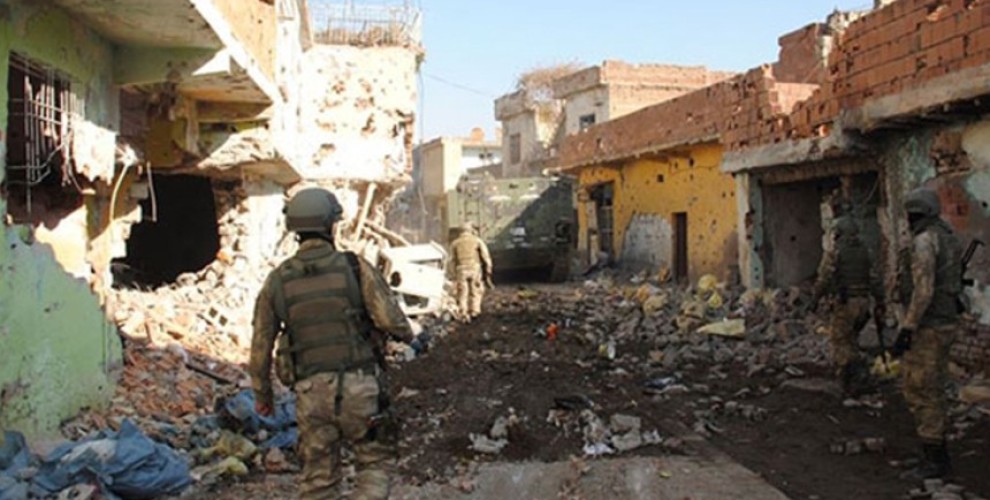Destruction of Sur on World Heritage Watch Report 2018
The deliberately destruction of Sur by the Turkish government was given wide coverage on World Heritage Watch Report 2018 and WİLL be discussed at International Forum.
The deliberately destruction of Sur by the Turkish government was given wide coverage on World Heritage Watch Report 2018 and WİLL be discussed at International Forum.

On June 22 and 23, 2018 there will be the International Civil Society Forum on World Heritage in Manama/Bahrain where a report on Sur (Amed), will also be discussed.
Just in the following days will be organized the 42nd UNESCO World Heritage Committee (WHC) Session in Manama.
At this session also the WH Site "Antique Villages in Northern Syria will be subject. Parts of this site have been bombed by the invading Turkish Army in January 2018 in Afrin/Rojava.
World Heritage Watch offers a platform for civil society actors and indigenous peoples to document concerns, to alert the World Heritage Committee, and to inform the wider interested public.
In the World Heritage Report 2018, just released, Sur features with the work titled, “Diyarbakir: A World Heritage Site Destroyed Deliberately by Turkey While UNESCO Keeps Silent”.
The authors are Ercan Ayboğa, Nevin Soyukaya and Necati Pirinçcioğlu and the Platform “No to the Destruction of Sur, Diyarbakir/Turkey”.
In 2012, a strong coalition of civil society actors and municipalities in Diyarbakir revised the “Urban Conservation Plan” for the fortified old city, called Sur or Suriçi, based on high priority social, cultural, and ecological criteria. They convinced the Turkish Government to nominate the site for the World Heritage List, and in 2015 the “Diyarbakir Fortress and Hevsel Gardens Cultural Landscape” were inscribed as a World Heritage (WH) Site.
The report by Ayboğa, Soyukaya and Pirinçcioğlu tells then the story of the brutal attacks on Sur and the various curfews imposed on the borough.
“With involvement of the military and heavy weapons, including tanks, the 6th curfew started on 11.12.2015 in Sur. The armed conflict, which ended officially on March 10, 2016, led to the death of some hundred people”.
Today the curfews still continue in five of six affected neighborhoods of East Sur. It is estimated that during the armed conflict around 400-500 buildings have been destroyed completely or mostly (there is no official governmental information).
The report confirms that “the fortress, part of the inscribed WH property, which was used by the Turkish military for their operations; it has suffered some damages. It is important to point out, however, that the principal physical destruction in Sur happened after the official end of state operations. In the blockaded areas, teams of the Ministry for Environment and Urban Planning started to systematically destroy also non-damaged buildings, including monuments, usingheavy equipment”.
The narrow roads have been broadened and entire parcels have disappeared. “In East Sur the demolition continued until summer 2017. - the report points out - Debris has been continuously excavated, quickly and roughly, and taken to different deposit sites”.
During this destruction the Turkish government did not make any serious effort to rescue authentic elements of monuments among the debris. All these actions have violated existing Turkish laws and regulations.
“Parallel to the destruction process, - the report adds - the Turkish government issued an expropriation order of Sur on March 21, 2016. This order had the objective to transfer Sur entirely to the government, and it includes also old mosques and churches”.
Up to now the expropriation has been implemented for a majority of the destroyed sections. Government has offered late, negligible financial support to people removed from subsequently destroyed areas.
In the meantime all local municipalities within Diyarbakir city, who had criticized the Government’s policy on Sur, have been seized. A state appointed commissioner was installed in November 2016, based on a decree made possible under the state of emergency. The local mayors were arrested, and the Urban Conservation Plan of Sur was revised immediately giving a legal basis for the destruction in progress.
The report also points out that in August 2017 the Turkish government decided to do “urban transformation” in the two neighborhoods of Feritköşk and Dicle with their 9000 inhabitants situated in the buffer zone of the Tigris Valley. This transformation is justified on the basis of poor construction conditions – an argument that holds partly true. As this area is of interest for investors, the planned new buildings will be sold at a high price, making them unaffordable for the former, mostly poor inhabitants. Again, these plans violate the original Management Plan, which foresaw that nobody needs to be displaced, and that the population‘s living conditions will be improved with different measures and technical-financial support”.
The full report can be found here:
https://www.world-heritage-watch.org/images/konferenz-reports/2018-Report_WHW.pdf